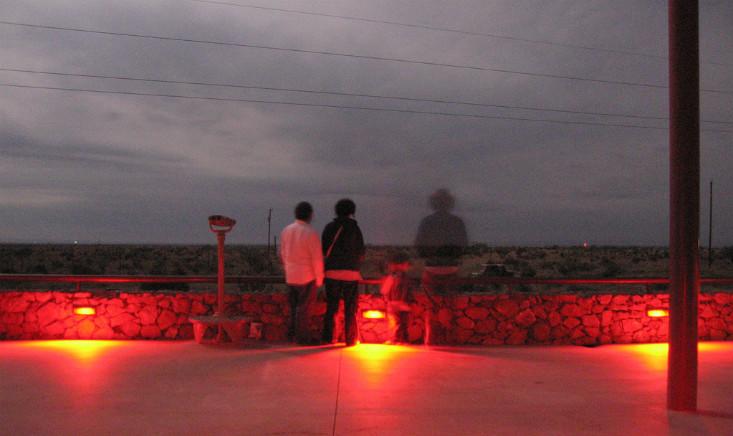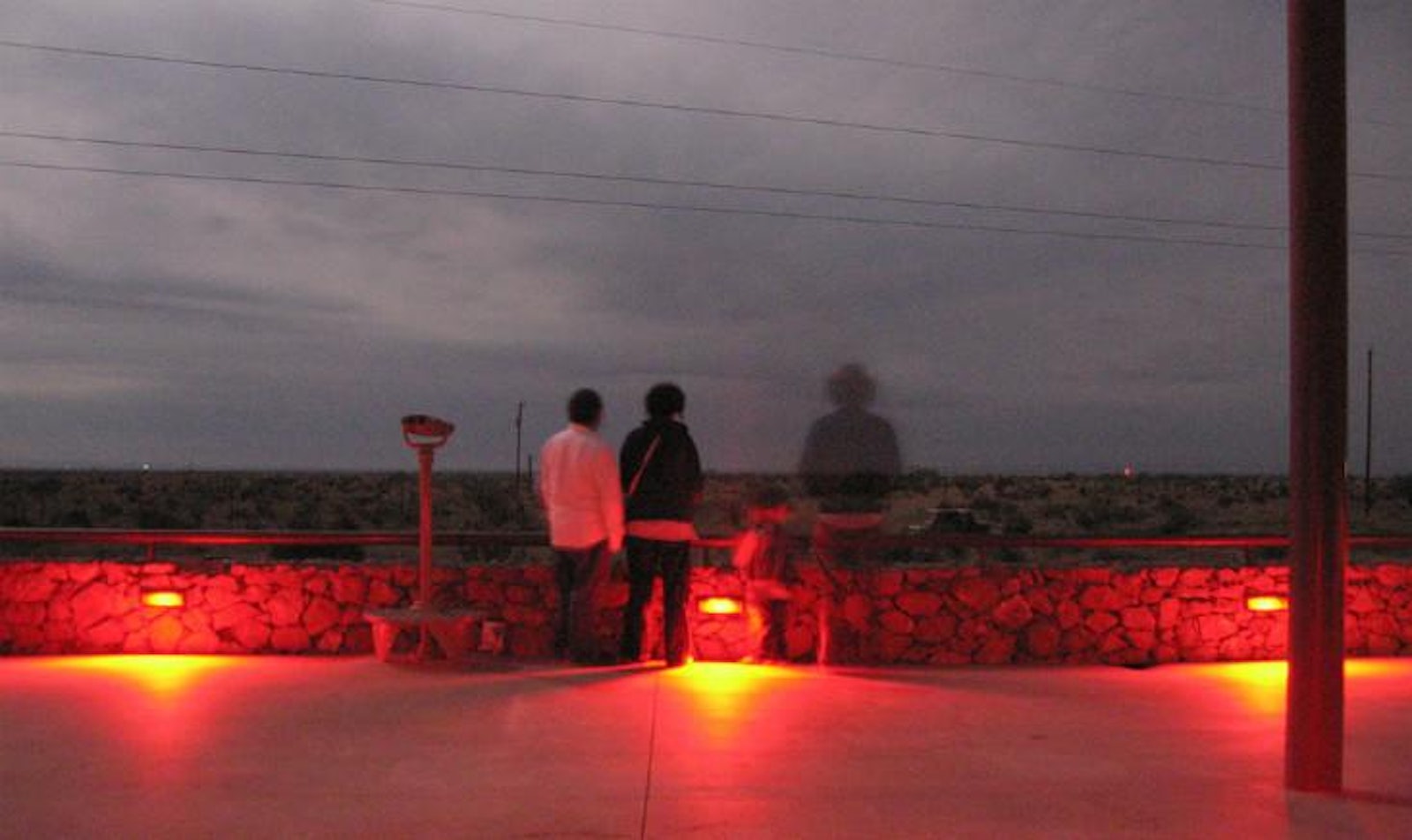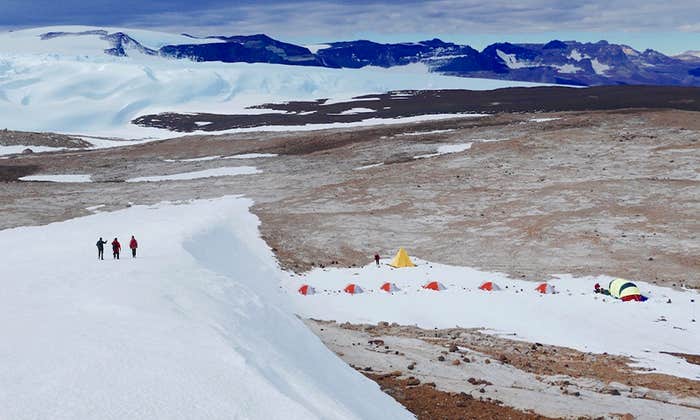
It was a warm summer night when my friends and I drove out to the middle of the west Texas desert and turned off the road at a big sign proclaiming, “Marfa’s Mystery Lights Viewing Area: Night Time Only.” We walked past a cylindrical adobe building—part of a viewing station built in 1986 and renovated a decade ago with roughly three-quarters of a million dollars of public funds—over to a row of telescopes perched on the wall adjoining it, expectantly pointed toward the horizon. Squinting across the black void of the grassy plain separating Marfa and its neighboring town, Alpine, we didn’t really know what we were supposed to be looking for. Like so much of the two weeks we spent snaking through the southern U.S. on our road trip that summer, we had done just enough research to know vaguely what we wanted to see, leaving the rest haphazardly up to luck. Unfortunately, when it comes to Marfa’s mystery lights, luck doesn’t often deal the hand you’re looking for.
The lore of the lights—big yellow-orange glowing orbs occasionally seen flying, splitting off, and merging into each other in an elaborate dance on the low horizon of West Texas—stretches back for centuries. According to its many legends, Native Americans speculated they were fallen stars; 19th-century cowboys ruminated on the potential threat of faraway Apache campfires; during World War I, townsfolk feared they were signals from an invading German army; rumor even has it that, during the Marfa-based filming of the 1956 classic Giant, James Dean spent his nights peering through a telescope, eager to catch a glimpse of the ever-elusive light show. Today, the Marfa lights still have next to nothing in the way of a definitive explanation.
But in 2005 speculation was temporarily cut short. A group of University of Texas at Dallas physics graduate students camped out near the viewing area, recording video of visible flashing lights southeast of Marfa. Correlating their footage with traffic patterns on nearby Highway 67, the students determined that all of the so-called mystery lights they had seen were actually attributable to headlights. To skeptics, that settled it.
But others who had seen the “true” lights disagreed. One man in particular, a retired aerospace engineer named James Bunnell, has been steadily collecting hundreds of hours of night-time video footage since 2000. Despite his diligence, he’s only captured them a few dozen times. From 2000 to 2009, for example, Bunnell identified only 60 “true” Marfa lights, and, since the lights tend to happen in clusters, they occurred over the course of only 31 nights. According to Bunnell, the key to identifying the outliers from the frequent occurrence of man-made lights lies in the sheer quantity of data he’s been able to collect: by comparing footage from his eleven low-light surveillance cameras in any given event, he can eliminate the usual suspects. Anything questionable, Bunnell claims, gets tossed out as well. “The biggest obstacle to gaining understanding of the Marfa lights is their rarity of occurrence,” he says. This means that most people who come back with fabulous tales of the Marfa lights really are just seeing cars. But, more importantly, some—according to Bunnell—are not.
“Short of being able to reproduce the lights with laboratory equipment, or finding a place where they occur with the regularity of old faithful in Yellowstone, I don’t know what’ll settle it.”
According to Bunnell’s ongoing analysis, natural conditions like humidity, atmospheric pressure, wind speed, temperature, and solar activity appear to play no role in causing the mystery lights. He’s seen some loose correlation with lunar events, but his current hypothesis is that they’re caused by hydrogen plasma bubbling to the surface through fault zones. A related theory, offered by Karl Stephan, a physics professor at Texas State University who has collaborated with Bunnell on a couple of papers, is that the Marfa lights may have something to do with so-called “earthquake lights.” These flashes, which occasionally appear soon before an earthquake strikes, were recently shown to be caused by high-intensity electric fields in portions of the earth’s surface that break loose during earthquakes. But Marfa is pretty seismologically quiet, and so Stephan stresses that—given the lack of a large data set—his guess is as good as anybody’s. Outside of Stephan and Bunnell’s investigations, other decidedly less rigorous hypotheses continue to be conjured up: the glowing “will-o’-the-wisp” phenomenon sometimes caused by swamp gas, rain-induced luminous bat poop, or the theory presented by one cryptozoologist from California, who speculates that glowing pterosaurs roam the west Texas desert at night.
Given the level of imagination the Marfa lights have inspired, it could be easy to dismiss sighting of the lights as mere quackery. Public curiosity about them has thus always greatly outweighed institutional scientific interest. It’s hard to imagine, says Stephan, what it would take to settle the mystery of the Marfa lights once and for all. He drew a connection to the history of meteorites: Scientific consensus at one time held that the idea that rocks from space could fall to Earth was total nonsense. “Short of being able to reproduce the lights with laboratory equipment, or finding a place where they occur with the regularity of old faithful in Yellowstone, I don’t know what’ll settle it,” Stephan says.
In the meantime, dozens of tourists continue to turn off an obscure highway in west Texas every night for a chance to carry their own Marfa-lights story back home with them. To many, it’s the mystery that makes the lights all the more alluring.
Azeen Ghorayshi is a freelance writer specializing in science, technology, and culture. Follow her on Twitter here.


























